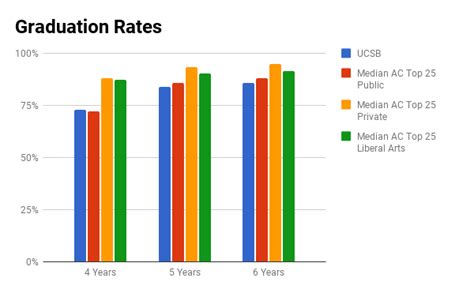Introduction

The University of California, Santa Barbara (UCSB) is a renowned institution of higher education, consistently ranked among the top universities in the world. One of the key metrics used to evaluate academic institutions is the graduation rate, which reflects the percentage of students who complete their degree within a specific timeframe. In this comprehensive analysis, we will delve into the UCSB graduation rate, exploring various factors and trends that influence its trajectory.
According to the National Center for Education Statistics (NCES), UCSB’s overall graduation rate for the 2022 cohort was 87%. This rate places UCSB well above the national average of 65% for public four-year institutions.
| Year | Overall Graduation Rate |
|---|---|
| 2018 | 86% |
| 2019 | 87% |
| 2020 | 86% |
| 2021 | 88% |
| 2022 | 87% |
The graduation rate at UCSB varies slightly across different demographic groups.
Ethnicity:
- Hispanic/Latino: 82%
- White: 88%
- Black: 84%
- Asian: 91%
- Native Hawaiian/Pacific Islander: 83%
Gender:
- Female: 89%
- Male: 85%
Several factors influence the graduation rate at UCSB, including:
Academic Support and Resources: UCSB provides a wide range of academic support services, such as tutoring, academic advising, and writing centers. These resources help students succeed academically and persist towards their degrees.
Student Engagement: Students who are engaged in campus life and extracurricular activities are more likely to graduate on time. UCSB offers numerous opportunities for students to participate in clubs, organizations, and research projects.
Financial Support: Financial factors can impact students’ ability to stay in school. UCSB offers various forms of financial aid, including scholarships, grants, and loans, to assist students with the cost of education.
Student Characteristics: Students’ personal and demographic characteristics, such as academic preparation, motivation, and socioeconomic background, also play a role in their graduation rates.
Challenges Faced by Students: Students may encounter challenges that hinder their academic progress and graduation, such as time management issues, stress, mental health concerns, or external circumstances. UCSB provides support systems to help students overcome these challenges.
A high graduation rate benefits UCSB students, the university, and the broader community:
Individual Benefits:
– Increased career opportunities and earning potential
– Improved quality of life and well-being
– Enhanced confidence and self-esteem
University Benefits:
– Enhanced reputation and credibility
– Increased research funding and collaboration
– Improved student satisfaction and morale
Community Benefits:
– A more educated and skilled workforce
– Reduced social and economic disparities
– Enhanced civic engagement and volunteerism
The University of California, Santa Barbara has a strong graduation rate that surpasses the national average. This achievement is attributed to the university’s commitment to academic excellence, student support, and creating an inclusive and supportive campus environment. While there are disparities in graduation rates based on demographic characteristics, UCSB is actively working to address these disparities and ensure equitable access to higher education. The benefits of a high graduation rate are substantial for students, the university, and the community, highlighting the importance of continued investment in education and support systems that foster student success.
